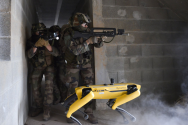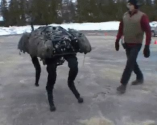I'm not sure why you would disagree.
We have no indication as to how much data they are actually collecting to train autonomy models, especially given these experiments we have seen so far seem to just involve a man in the loop controlling the dog.
Heck even if they were collecting data for future autonomy, that remains such a basic and foundational piece of research that they remain preliminary and gestational and certainly not large scale.
Taking a robot dog to a few overseas exercises for the purpose of showing off doesn't mean much -- large scale would be something like equipping every platoon in every combined arms brigade of a theater command with a robot dog at minimum.
What we are seeing right now is the equivalent of playing with remote control toys. They are only a faint vision of what the future capability will be.
This is the beginning phase of what I see have already happened in ADAS industry.
Have you taken a look at Unitree Go2? if you haven't, then you should
It uses advanced 4D Lidar tech that significantly improves IDing of objects
This is pretty far ahead of the sensors that Boston Dynamics Spot uses (which I assume is the best that US army could work with)
which is basically IMU + vision
That's imo just pure garbage
It also got in with Hydraulics drive robot at that early stage and have now realized that doesn't work and is finally moving to electric drive
This is all emblematic at a subpar system developed at great cost at a time when autonomous tech simply was not ready for market yet.
And that's what US army is stuck with.
Go 2 only came on unveiled in July & PLA already has it in oversea exercises. We've also seen them train Go 2 with drones carrying them and transporting them to destination.
That's pretty fast progress for a few month
Unitree itself talks about AI & Robot GPT used to make decisions, which over time through field deployment is how you collect data to continue to refine the model
So given what I've seen just in a few months, I can extrapolate this over a few years and see them mass produce a bunch of dogs that operate autonomously.
That's just not possible with US military & Boston Dynamics. It's like watching Mobileye in action in ADAS. An earlier player stuck with archaic technology & enable to move forward. Also built a system that is too costly to see mass adoption in civilian field, which means they won't be able to scale up production.
Whereas for Unitree, when you price something like $1600, you know it's going to see a whole bunch of demand around the world and see huge vertical scaling, enabling robot dog army in the future.
When I posted these clips in response to robot dog army, it wasn't about what they have now, but what will they have. The key here is that they have the domestic firms here with commercializable product that is clearly moving very fast. I could be jumping the gun here in thinking they will get to a certain point in say 5 years, but what I've seen in EV and drones industry tells me that I'm not.



